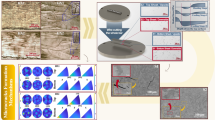Abstract
The wetting properties of powders are important in many technological processes. Contact angles can be characterized by an effective contact angle of the particle arrangement relative to the wetting liquid, but their quantification is problematic. An exact determination depends on an accurate preparation of the test samples. A defined pre-consolidation by vertical shocks is introduced in this paper.
Similar content being viewed by others
Abbreviations
- H :
-
wetting height (m)
- S V :
-
specific surface (m2/cm3)
- t :
-
wetting time (s)
- x :
-
particle size (μm)
- x 50 :
-
median of the particle size distribution (μm)
- \({\varepsilon}\) :
-
porosity
- η l :
-
dynamic viscosity of the liquid (Pa s)
- ρ s :
-
density (kg/m3)
- \({\Theta_{\rm eff}}\) :
-
effective contact angle (°)
- γ lg :
-
surface tension liquid–gas (mN/m)
References
Carman P.C. (1956). Flow of gases through porous media. Butterworth, London
Darcy, H.: Les fontaines publiques de la ville de Dijon. In: Libraire des Corps Impériaux des Ponts et Chaussées et des Mines, Paris, 1856
Hoffmann, U.: Einfluss des Frittenwiderstandes auf die Randwinkelmessung bei der Steighöhenmessung nach Schubert. Diploma thesis, TU Bergakademie Freiberg (2003)
Newitt D.M., Conway-Hones, J.M.: A contribution to the theory and practice of ganulation. Trans. Inst. Chem. Eng. 36, 422–442 (1958)
Richter, A.: Herstellung definierter Schüttgutdichten sehr feiner Pulverproben für die Randwinkelmessung nach der kapillaren Steighöhenmethode. Diploma thesis, TU Bergakademie Freiberg (2005)
Richter, S.: Herstellung definierter Schüttgutdichten für Randwinkelmessungen nach der kapillaren Steighöhenmethode. Diploma thesis, TU Bergakademie Freiberg (2004)
Schubert H. (1993). Instantization of powdered foods. Int. Chem. Eng. 33(1): 28–45
Schubert H. (1978). Optimierung der Größe und Porosität von Instantagglomeraten in Bezug auf eine schnelle Durchfeuchtung. Verfahrenstechnik 12(5): 296–301
Teipel, U., Mikonsaari, I.: Determining contact angles of powders by liquid penetration. In: Proceedings of the 4th International Conference for Conveying and Handling of Particulate Solids, Budapest, vol. 1, 4.57, 2003
Thümmler, S., Höhne, D., Husemann, K.: Characterization of the Wetting Properties of Hydrophobic Powders by means of the Capillary Rise Method. In: 16th International Congress of Chemical and Process Engineering, Prague, 22–26 August 2004
Thümmler S., Höhne D. and Husemann K. (2005). Charakterisierung der Benetzungseigenschaften hydrophober Pulver mit der kapillaren Steighöhenmethode. Chem. Ing. Tech. 77(3): 297–300
Washburn E. (1921). The dynamics of capillary flow. Phys. Rev. 17: 228–236
Wollny, M., Schubert, H.: Eine neue Methode zur Bestimmung des zeitlichen Benetzungsverhaltens von Partikelschüttungen. In: Dechema-Jahrestagung, Kurzfassungen Band II, S. 369–371, 1999
Author information
Authors and Affiliations
Corresponding author
Rights and permissions
About this article
Cite this article
Thümmler, S., Höhne, D. & Husemann, K. Preparation of defined bulk densities for using the capillary rise method in the case of fine powders. Granular Matter 10, 309–314 (2008). https://doi.org/10.1007/s10035-008-0098-y
Received:
Published:
Issue Date:
DOI: https://doi.org/10.1007/s10035-008-0098-y




